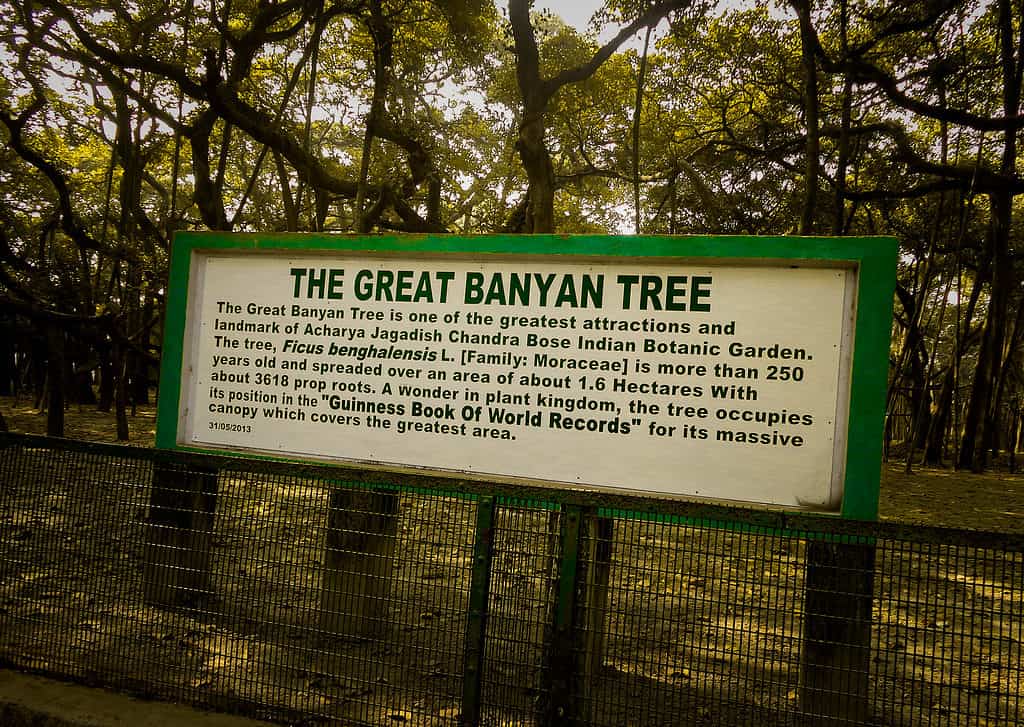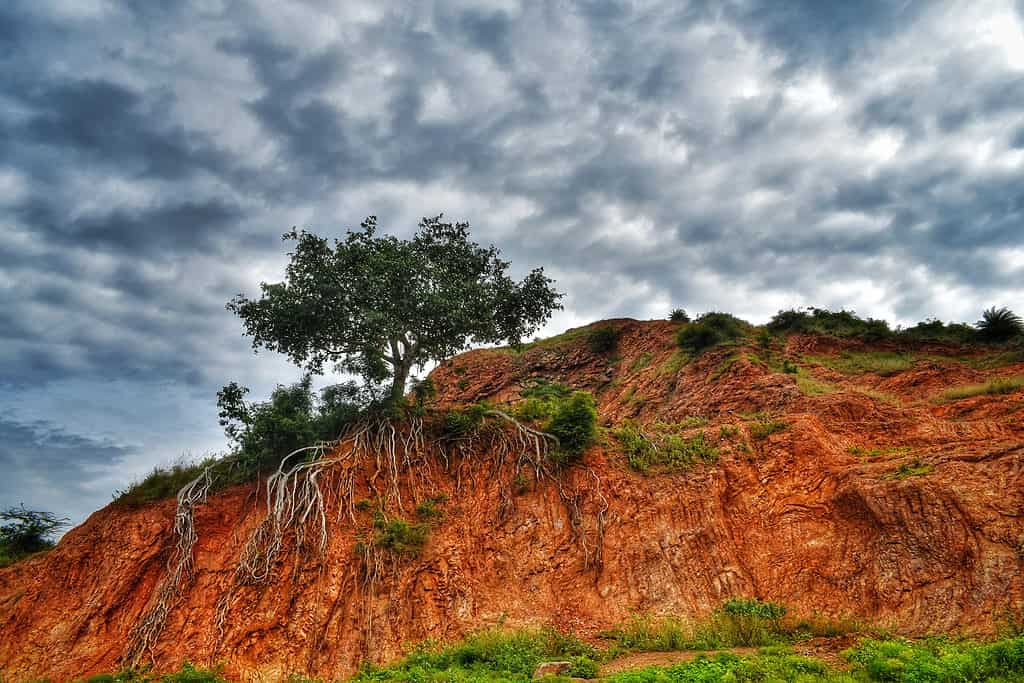Banyan trees are some of the most interesting trees in the world, particularly because of the unique way that they grow. These strange and mysterious trees can grow especially large, with the largest one in the world bringing millions of people a year to see it. Today, we are going to meet that tree and learn a little more about it! Let’s discover: What is the largest banyan tree in the world?
What is a Banyan Tree?

A Banyan tree is a type of fig tree that is native to India and Southeast Asia. They are known for their distinctive aerial roots which grow from the branches and eventually reach the ground, where they take root and grow into new trunks.
©imageBROKER.com/Shutterstock.com
A Banyan tree is a type of fig tree that is native to India and Southeast Asia. They are known for their distinctive aerial roots which grow from the branches and eventually reach the ground, where they take root and grow into new trunks. These aerial roots give the tree its characteristic wide, spreading canopy and can make it difficult to determine where the original trunk ends and the new growth begins. As long as the tree isn’t killed, banyan trees are able to, theoretically, expand forever.
Banyan trees are known for their size and longevity and can live for hundreds of years. They are considered sacred in some cultures and are often found near temples and other religious sites. In Hinduism, the Banyan tree is considered to be the tree of immortality and is often associated with the god Vishnu.
Banyan trees are typically found in tropical and subtropical regions, where they thrive in warm, humid climates. They are commonly found in India, Bangladesh, Sri Lanka, Myanmar, and throughout Southeast Asia, as well as in parts of the Pacific and Caribbean islands. They can also be found in subtropical and tropical regions of the United States, Africa, and Australia, where they are intentionally grown in various garden settings.
The Worlds Largest Banyan Tree
The Great Banyan is a botanical wonder that has stood the test of time. Located in the Acharya Jagadish Chandra Bose Botanical garden in Howrah, India, this banyan tree is considered to be the largest in the world and one of the largest organisms on the entire planet. Spanning over 3.5 acres and measuring over 80 feet tall, the Great Banyan creates its own forest from the natural offshoots that grow into the canopy.
Despite facing two cyclones in 1864 and 1867, the Great Banyan is still around and continues to thrive. The tree is unique in that it has no main trunk, as it decayed and was removed in 1925. Instead, its branches spread out to form a canopy over the entire area. Its 3,600 roots create a forest-like experience. Walking under the canopy feels like moving through a large forest, despite each “tree” in the forest just being a further extension of the original tree. With so much biomass spread out over acres of land, it’s easy to see how the Great Banyan is considered one of the largest organisms on the planet.
Guinness Book of World Records
The Great Banyan is also known as the “walking tree” because it continues to grow in width. In 1989, it was officially inducted into the Guinness Book of World Records as the world’s largest tree by canopy and that covers the largest area. A long road was built around the tree so that tourists could drive around the entire circumference of the structure. It has since grown outside the bounds of the road!

The Great Banyan is a botanical wonder that has stood the test of time. Located in the Acharya Jagadish Chandra Bose Botanical garden in Howrah, India, this banyan tree is considered to be the largest in the world and one of the largest organisms on the entire planet.
©Dhritiman Kataki/Shutterstock.com
What Makes Banyan Trees So Large?
Banyan trees are known for their immense size and longevity. They are able to grow so large due to several factors. Firstly, their aerial roots grow from the branches and eventually reach the ground. Once on the ground, where they take root and grow into new trunks. This allows the tree to spread out and grow in multiple directions, giving it a wide, spreading canopy.
Secondly, Banyan trees are capable of surviving in a wide range of soil conditions. It can grow in areas where other trees cannot. They have a deep taproot system and a strong root structure. These allow them to absorb water and nutrients from a large area, which aids in their growth.
Additionally, Banyan trees are able to survive for centuries, which gives them time to grow to massive sizes. They are also able to adapt to changing conditions. They can survive in adverse conditions such as droughts, floods, and storms. Their ability to adapt and survive in harsh conditions makes them a hardy tree species.

Banyan trees are capable of surviving in a wide range of soil conditions and can grow in areas where other trees cannot.
©Ravikanth Bora/Shutterstock.com
The Importance of the Banyan Tree in India
The banyan tree is especially revered in India. In fact, these fig trees are the national tree of India. Although they are technically fig trees, the fruits are generally used as food, although they aren’t edible. They are only rarely eaten in the toughest of times, although it does occasionally happen.
Still, even outside viewing it as a food source, the banyan tree is incredibly beautiful. It is clearly one of the most majestic organisms on the planet. A beautiful and endlessly expanding tree must have some deep internal significance, right?
Bonus: What Types of Wildlife Live in the Banyan Tree?

Indian
Myna Acridotheres tristisoften reside in banyan trees.
©T G Santosh / CC BY-SA 3.0, via Wikimedia Commons – License
We have learned that the banyan tree is important to Hindu and native cultures – but what does it mean to the animals that live in it? For many bats, birds, and other animals it is home – and many strangler figs are considered to be keystone species because they provide food to a variety of animals during rough times when food is scarce.
Parrots, hornbills, toucans, howler monkeys, gibbons, and bats all benefit from the fruit of the banyan tree. In Samoa, the rare Many-colored fruit dove can only be found on a banyan – while barn owls frequently sleep and nest in the hollow trunks.
In India, as many as ten species of birds co-exist in one banyan – like an avian apartment complex. Crows roost on the top floor branches with mynas occupying the middle floor. Smaller birds live in the bottom branches. Birds often fight over the most comfortable branches when a family moves out! Bird watchers in India marvel at the symphony of sounds coming from the birds at sunrise in the mornings. Crows, cuckoos, sparrows, and more are heard – with the myna birds calling the loudest of all.
The photo featured at the top of this post is © Ralf Broskvar/Shutterstock.com
FAQs (Frequently Asked Questions)
How large is the Great Banyan Tree?
The Great Banyan is a botanical wonder that has stood the test of time. Located in the Acharya Jagadish Chandra Bose Botanical garden in Howrah, India, this banyan tree is considered to be the largest in the world and one of the largest organisms on the entire planet. Spanning over 3.5 acres and measuring over 80 feet tall, the Great Banyan creates its own forest from the natural offshoots that grow into the canopy.
How do banyan trees get so large?
Banyan trees are known for their immense size and longevity. They are able to grow so large due to several factors. Firstly, their aerial roots grow from the branches and eventually reach the ground. Once on the ground, where they take root and grow into new trunks. This allows the tree to spread out and grow in multiple directions, giving it a wide, spreading canopy.
Thank you for reading! Have some feedback for us? Contact the AZ Animals editorial team.






